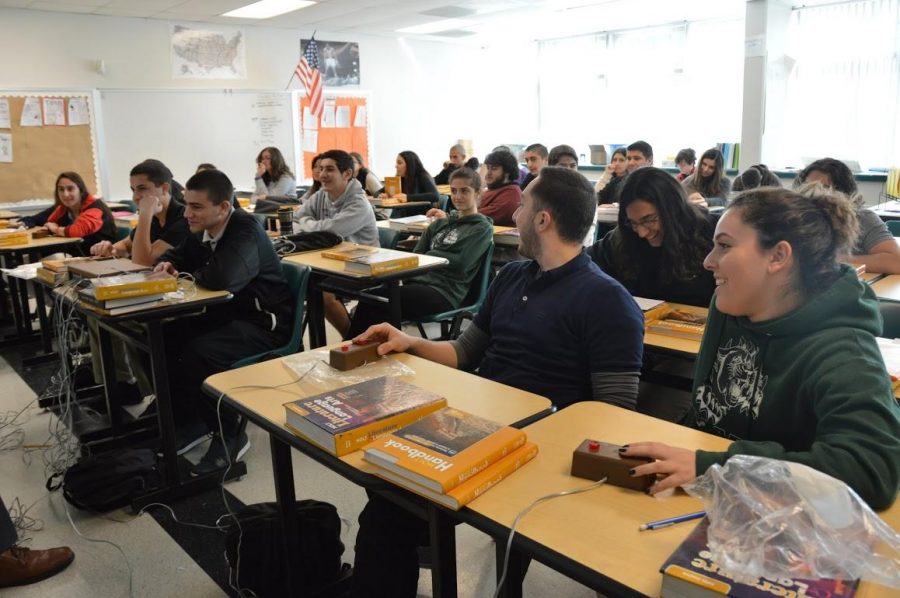Class size varies throughout school
Photo taken by Savanna Gharibian
Typical Clark Magnet High School class size
41, 41, 40, 39, 23, 19, 28.
These random seven figures represent different class sizes from all over Clark Magnet High School this school year. But how can some classes have 41 students and others can only have 23 or 28? Well, “It’s a number’s game,” as Principal Doug Dall said. Because the Glendale Unified School District funds the school for 38 students per classroom, some classes are larger than the average and some are smaller. But at the end of the day, the average size of all classrooms at Clark Magnet High School — and the other three comprehensive high schools — is 38.
Politicians and school board members have promised to reduce the size of these large classes and it seems like they have found some success. Some seniors are enrolled in classes with only 23 students, something unheard of at Clark and many other public schools.
“My AP Spanish class consists of only 23 students,” said senior David Agajanian. “I love my smaller AP Spanish classes because I can give immediate feedback to the students’ writing and speaking,” said AP Spanish teacher Victoria Marcucci. Marcucci also believes that with her smaller classes, students are able to participate more in class, which she believes helps students improve their Spanish language skills.
However, AP Spanish is not the only small class at Clark Magnet as Virginia Benzer’s AP Biology classroom holds fewer than 30 students. “In my opinion, AP classes should be limited to 25,”Benzer said. “Class size affects whether or not you’re going to learn something.”
At the other end of the spectrum, several AP classes have more than 40 students per class. According to AP Chemistry teacher, Loussik Kassakhian, her period three AP Chemistry class has 41 students. “It’s very difficult to teach such a huge class,” she said. “I can’t recognize their weaknesses and I don’t have time to answer their questions. It’s not fair for the students.”
Kassakhian, though, is not the only teacher dealing with huge AP classes as teachers Armineh Mikaelian, Stephanie Sajjadieh and Nancy Witt are facing similar large numbers of students in their respective AP classes.
“I have two AP English Lit. classes with 41 students in each,” Sajjadieh said. “Normally, I wouldn’t mind, but because the course is writing based it becomes very hard to grade papers and give students immediate feedback.”
The new AP US History teacher, Nancy Witt, has taught at schools all over the district and has never taught large AP classes like her current classes. “When I was teaching at CV, I had classes of about 35. And here my two classes have 40 and 39 students each. Although the five student difference does not look like a big deal on paper, it makes a huge difference,” Witt said.
And AP students are not the only students being affected, as the freshman class is too. According to Counselor Susan Howe, some physics classes have more than 39 students per classroom.
But the simple question at this point would be, why do some classes have only 25 students and others have more than 40? Well, as Principal Doug Dall said, “It’s a numbers game.” Every year when the administration and counselors make the master schedule they have to make decisions that affect class size.
For example, consider a group of 90 students signing up to one AP class. If 90 students sign up for that course, that means there can either be three classes of 30 students each or two classes of 45 students each. This decision is made by the administration.
Administrators have to account for what subject the class is and how important it is for a smaller teacher-to-student ratio. In addition, the likelihood of students dropping that class must also be considered. As Counselor Susan Howe explained, the administration counts on several students wanting to drop their AP classes because some students don’t know how much work their class is until they are in it.
And that’s why some classes at the beginning of the year had 45 students and now have only 41 or 39 students. “The first day of school, my AP Chemistry class had 45 students and now it only has 41,” Kassakhian said. “I expect more students to begin dropping the class after they really understand the rigors of this course.”
Class sizes across all classes can be reduced through additional state funding. Recent signs have been hopeful as California has been improving education funding for its students.
Last year, according to the Washington Post, state officials expected California to have a surplus of $4.2 billion, with many politicians arguing about which public institution should receive the funding. Gov. Jerry Brown has already increased spending by $10 billion in his state budget towards K-12 public schools, but as state rankings have shown countless times, California is very far from anywhere near the best in the country. And then the money given to the schools has to be divided upon many other budget issues, such as teacher salaries, school equipment and adding new teachers.
These class reductions will not happen overnight, but they may happen in future years. “I know the state is trying to improve public school education,” said senior Artur Arzrunyan. “But I also know that the changes that they finally make will ultimately not affect my education as they are a long time away from being implemented.”

INTERESTS/HOBBIES: -
EXTRACURRICULAR ACTIVITIES: -
THREE WORDS TO DESCRIBE ME ARE: Amazing
IN TWENTY YEARS: -
FAVORITE...








